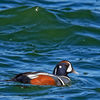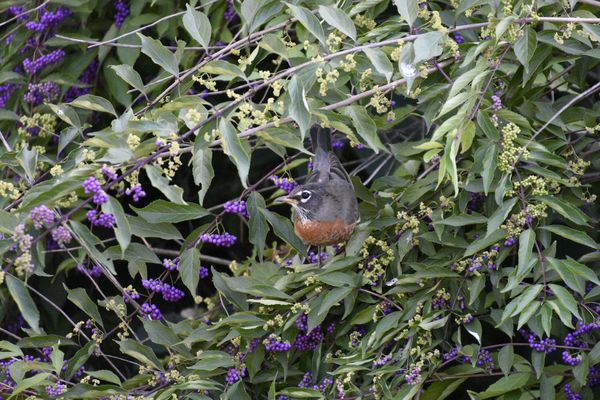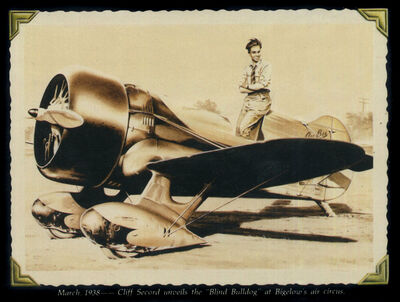Shutter mode, aperture mode: question about meter with Nikon
Oct 15, 2017 09:09:39 #
jccash wrote:
I use the same rig and also live in Florida. Seems like the 200-500 was made for the D500. My wife is getting me a monopod for my BD next month. Fun hobby
Not a bird in flight but I was about 200 feet last month when I captured Rocky the Raccoon
Not a bird in flight but I was about 200 feet last month when I captured Rocky the Raccoon




Oct 15, 2017 09:21:38 #
Einreb92 wrote:
I almost always shoot in manual, but lately, I’ve been trying to get bird shots under less than ideal lighting conditions and began using shutter mode. When I do, am I to disregard the meter reading and assume the camera will do the rest to render the best possible shot? I have the same questions about the other non-manual modes as well.
Do not disregard your meter reading, it is there for a reason. The meter reading gives you an idea of what is happening with the light at that time. As you most likely know, meter readings are generally about an 18% or so range reading, so they create a place to start from in any case. If you are shooting with your shutter your meter reading and your focus point are one and the same, this creates a situation where your meter reading can be off depending upon where your focus/metering point is set. You will need to correct for this with - or + exposure compensation. If you are shooting back-button autofocus you can focus and then move the point to a meter reading where you are on the brightest part of the subject and the meter reading will give you a more accurate reading for the subject, although you may still have to correct the reading. The camera meter reading provides a middle of the road meter reading and the photographer needs to provide correction as needed for the subject and lighting. If you set your shutter at a specific setting then you move ISO or aperture to get a correction, based on what you want. In general, with bird shots, I shoot aperture priority and set it from f/5.6 to f/8, depending upon the light and situation: my correction comes from the ISO, not the shutter as I want the shutter to remain fairly fast. However, if the shutter is much faster than I need I can correct with the shutter and leave the ISO alone to get a smoother shot. It's a constant "dance" of sorts and knowing your camera well helps a lot so that you can correct quickly. I have many successful shots of birds in flight (see the links below my name) so what I do has worked well for me in practice. I check my histogram often when shooting as well to insure that I am in the ballpark range for any correction in post that may be needed.
Oct 15, 2017 09:45:34 #
If you use Shutter Priority mode you must watch the meter because it can easily be at maximum aperture and still isn't enough light and in such case you will have underexposure and the meter will indicate that.
If you use Aperture Priority there is less likely there will be an over or underexposure but there is good chance that the shutter speed get too slow for hand holding or for the moving subject. So you must watch the meter too.
In fact when you use any form of auto exposure the meter is the master so you must watch it.
You should disregard the meter if you determine the exposure yourself or with and handheld meter.
If you use Aperture Priority there is less likely there will be an over or underexposure but there is good chance that the shutter speed get too slow for hand holding or for the moving subject. So you must watch the meter too.
In fact when you use any form of auto exposure the meter is the master so you must watch it.
You should disregard the meter if you determine the exposure yourself or with and handheld meter.
Oct 15, 2017 09:51:05 #
Good points but keep in mind that Exposure Compensation is nothing more than changing the shutter speed or aperture in most cases depending upon the mode you are shooting.
Best,
Todd Ferguson
Best,
Todd Ferguson
via the lens wrote:
Do not disregard your meter reading, it is there f... (show quote)
Oct 15, 2017 09:51:25 #
Oct 15, 2017 10:23:01 #
Einreb92 wrote:
I almost always shoot in manual, but lately, I’ve been trying to get bird shots under less than ideal lighting conditions and began using shutter mode. When I do, am I to disregard the meter reading and assume the camera will do the rest to render the best possible shot? I have the same questions about the other non-manual modes as well.
Why not just practice both ways and see what works best?
Oct 15, 2017 10:56:22 #
When you are in aperture priority, shutter priority, or auto iso, the camera is going to try to give you the correct exposure for 18% gray. If you are shooting a snow-filled frame, the snow will be underexposed and look gray in the photo unless you tell the camera that it should increase the exposure by using exposure compensation. Conversely, if you are shooting a black bear on a dark background, the bear will now become a grayish black and not purely black because the camera is now overexposing to make the black 18% gray.
Oct 15, 2017 11:01:06 #
Einreb92 wrote:
I almost always shoot in manual, but lately, IâÂÂve been trying to get bird shots under less than ideal lighting conditions and began using shutter mode. When I do, am I to disregard the meter reading and assume the camera will do the rest to render the best possible shot? I have the same questions about the other non-manual modes as well.
CatMarley wrote:
Why not just practice both ways and see what works best?
Thanks you all for your suggestions and valuable information. Of course this quandary is typical of the relative newbie that I am. Here is where my confusion comes in play. While some of the birds are in motion, it is mostly because I catch them, while they are moving from one branch to another. I am not discussing catching them in actual flight...at least not yet? Lol. Mainly, I have been capturing them from a second-story window (open of course) where they perch against a backdrop of verdant leaves of several bushes on the western side of the yard. My office window is my version of a blind. The lens (Tamron 70-300) is not very fast at 5.6, maximum reach, especially if the light is low, which it often is, given the location of the area these birds seem to favor. But it can render nice images, IMHO.
I tried shooting the birds at slower shutter speeds allowing more light, but then the ISO ended up rendering an image with more noise than I cared for, and the images weren’t as sharp as I wanted. So I figured what the heck and set for shutter speed of 500-800 in S mode. While the image sooc is often darker than optimal, I have had great success in PP. All of this while ignoring the meter. Then it dawned on me that maybe the D7200 software wasn’t actually doing what I thought it was doing, and so decided to ask the more experienced here. Ultimately, this IS the experiment and I am having trouble interpreting the results. I feel the solution is to return to full manual, but often, the time it takes to make the adjustments is twice the time it takes for the subject to fly away.
Oct 15, 2017 11:17:07 #
Einreb92 wrote:
I almost always shoot in manual, but lately, I’ve been trying to get bird shots under less than ideal lighting conditions and began using shutter mode. When I do, am I to disregard the meter reading and assume the camera will do the rest to render the best possible shot? I have the same questions about the other non-manual modes as well.
Honestly, it's better to use aperture priority on birds when lighting is less than ideal. Just remember to open up all the way and then up your ISO. You have to be careful using shutter priority because if you set it and then it maxes out your aperture to wide open and there's not enough light, you will get images that are underexposed. When using aperture priority, it won't max out your shutter since your shutter can go all the way down to 30 seconds if need be. But you will be able to see blurry pictures if your shutter becomes too slow or you'll hear the slow shutter. When that happens, increase your ISO. Learn good shooting techniques when shooting with slow shutters. It's not easy and you'll get a lot of blurry pictures, but sometimes you will luck out and get a good one.
Oct 15, 2017 11:21:10 #
jeep_daddy wrote:
Honestly, it's better to use aperture priority on ... (show quote)
Thanks, Jeepdaddy. I will give your suggestion of aperture mode a try. But with a 4-5.6 lens, there doesn’t seem to be much wiggle room.
Oct 15, 2017 11:26:55 #
Einreb92 wrote:
I almost always shoot in manual, but lately, I’ve been trying to get bird shots under less than ideal lighting conditions and began using shutter mode. When I do, am I to disregard the meter reading and assume the camera will do the rest to render the best possible shot? I have the same questions about the other non-manual modes as well.
I use Aperature or Shutter the most. Nikon has designed an incredible computer in my D810. Occasionally I use my grey card and separate light meter. Setting are the same that the camera suggests
Oct 15, 2017 11:35:45 #
billnikon wrote:
When shooting birds in flight I like Aperture Prio... (show quote)
...this is what I see most experienced bird photographers doing...it creates more of the bokeh you want to isolate the bird and capture the motion in flight...
Oct 15, 2017 11:44:51 #
I fail to understand why many photographers believe that they should “graduate” to manual mode as a route toward becoming a better photographer while using a sophisticated camera with a built in light meter. I stopped using a match needle camera, ie manual, with my Canon FT in the early 1970s. When I shoot portraits I generally shoot aperture priority as I want to control depth of field. With strobes I shoot manually because I use the shutter speed to control ambient light. I generally shoot shutter priority with landscapes because my 5dsr really works best at slightly higher shutter speeds. Use you technology, of learn to use a hand held incident light meter and ignore your camera’s built in meter..
Oct 15, 2017 11:47:13 #
bweber wrote:
I fail to understand why many photographers believ... (show quote)
You are right! One should not graduate to manual mode but rather like you graduate to auto modes. It takes more knowledge to use auto modes.
Oct 15, 2017 11:48:30 #
SkyKing wrote:
...this is what I see most experienced bird photographers doing...it creates more of the bokeh you want to isolate the bird and capture the motion in flight...
Maybe so. But given the distance I am from the subject, and the closeness of the subject to the background, am I correct in saying depth of field vis a vis bokeh will always be at a minimum?
If you want to reply, then register here. Registration is free and your account is created instantly, so you can post right away.









